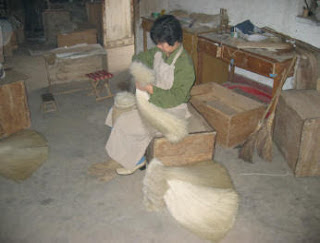I have been importing horse tail hair since my first trip to China in 1999. From my experience, many bow makers and luthiers still lack a clear understanding of how horse tail hair is sourced for the Western market. Rumors and misconceptions persist in the industry, with many believing that high-quality bow hair must come from Mongolia or that Siberian and Japanese hair are the best options.
Having spent considerable time selling bow hair and discussing it with customers (as well as students in classes at UNH), I wanted to share some insights here as well.
About 80% of the horse tail hair sold in North America originates from the Northeast region of China and Inner Mongolia. Generally, the Chinese market does not purchase much hair from Mongolia or Siberia, but they do import a significant amount from South America, where they have established long-term relationships with suppliers.
The hair that is imported arrives at the workshop—more of a small, bustling facility than a factory—typically in large burlap bags. The cleaning process begins outdoors in large cement vats, using cold water and detergent. Workers clean the hair by hand, using wooden mallets to agitate it. If dyeing is required (as is often the case for companies like Glasser or P&H), the dye is added at this stage. If not, the hair is washed again in a small shed with hot water, heated by a coal furnace, and then rinsed with cold water. All these processes are done by hand.
After washing, the hair is moved to a dark, dry storage area on pallets to be air-dried, with workers turning it frequently throughout the day to ensure even drying.
Once dried, the hair is brought into the main workshop for combing, sorting, and bundling. Using two-kilogram bundles, the hair is first hackled—this involves pulling the hair over metal spikes to straighten it for easier handling later. Although the hackling process looks somewhat aggressive, it results in beautiful hair, challenging the notion that horse hair is particularly fragile.
After hackling, the hair is loosely tied and stacked for the next stage. A worker combines three bundles, tying them off and wrapping them in heavy-duty paper, strapping them with thin wooden pieces for tightening. Once a bundle is ready, she draws several strands out at a time, butting them in her left hand. I’ve seen variations of this process, such as Michael T. Sowden’s method at the VSA show, which involves drawing from hair that has already been sorted.
After the hair is drawn, it is tied off and set aside. Another worker then uses a wooden paddle to align the butt ends of the hair before tying it off again.
Now that the hair has been cleaned, dried, hackled, drawn, and butted off, it undergoes a critical final sorting process. This is the most meticulous step, and many pieces of hair do not pass through it. I require this process, however.
A worker places the hair on white paper in the best-lit area of the workshop—often outside or in a well-lit office foyer during winter. She inspects each strand, removing any deemed unsuitable: chalky whites, thick strands, discoloration, or damage. This meticulous work can take up to an hour. Once completed, the sorted bundle is handed off to another worker with 30 years of experience, who repeats the process.
Once the final sorting is complete, the hair is bundled for storage and shipping. It's impressive to watch; two workers at one table efficiently tie the bundles to cords hanging from the ceiling, using both hands and their teeth to secure them tightly.
Finally, the bundles are packed into cardboard boxes with paper separators, labeled, and prepared for shipping.
I frequently travel to China and have attended music trade shows in Shanghai and Beijing. I’m always happy to answer any questions about bow hair or share my experiences in China.






















